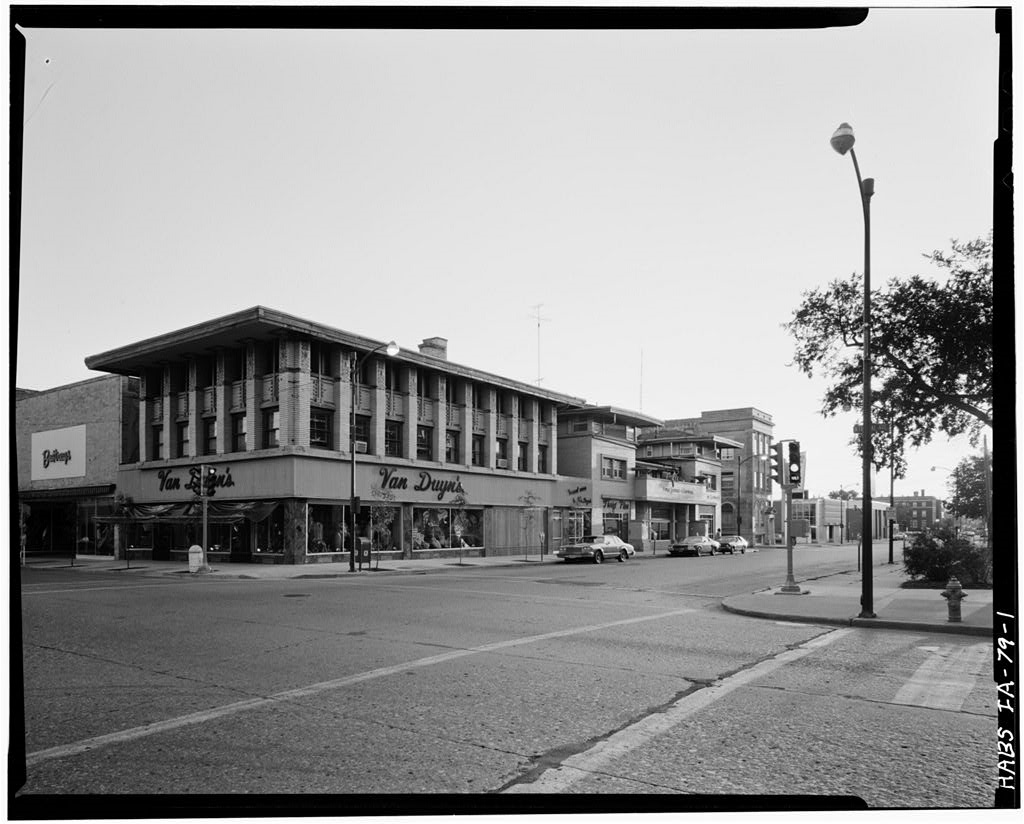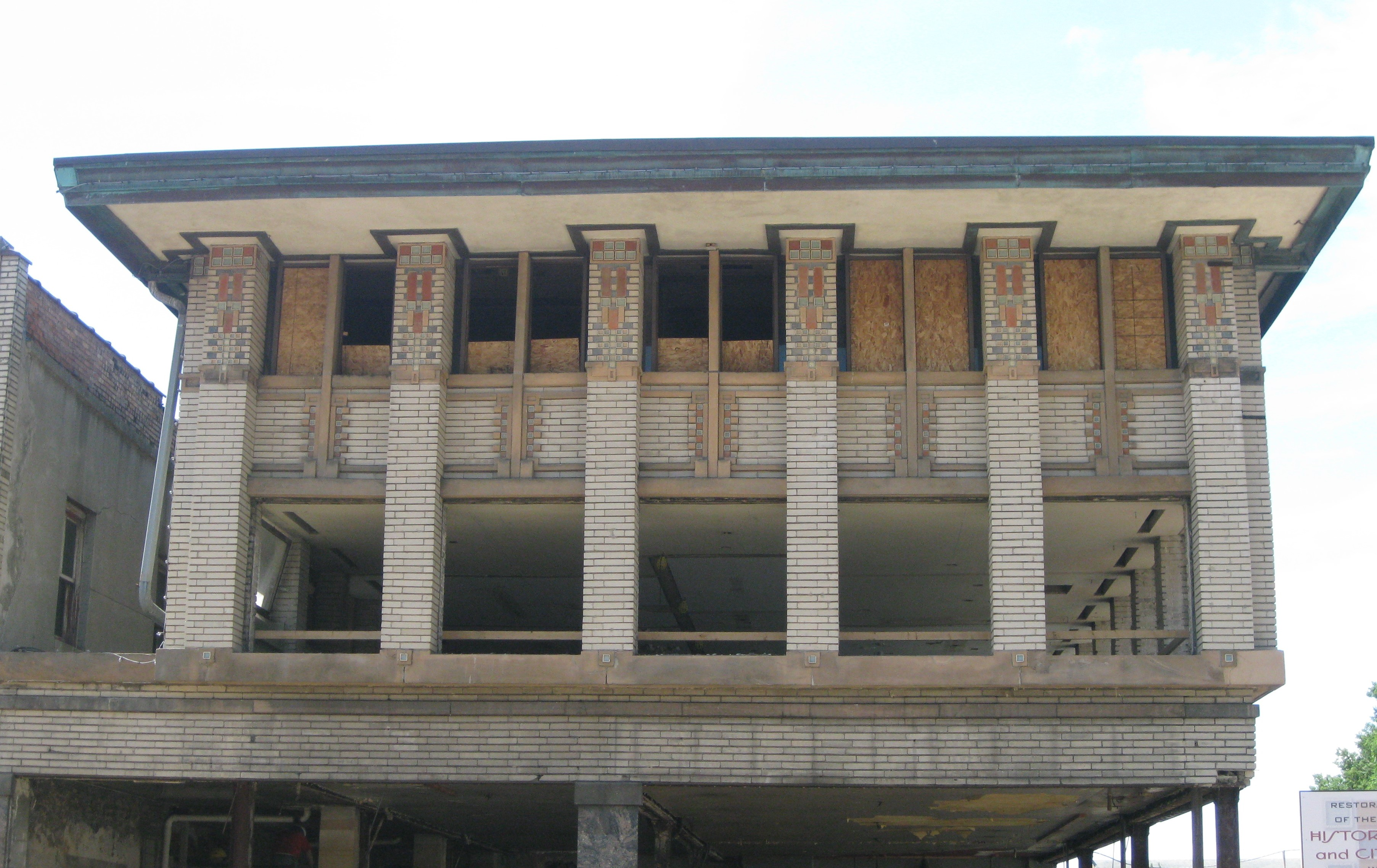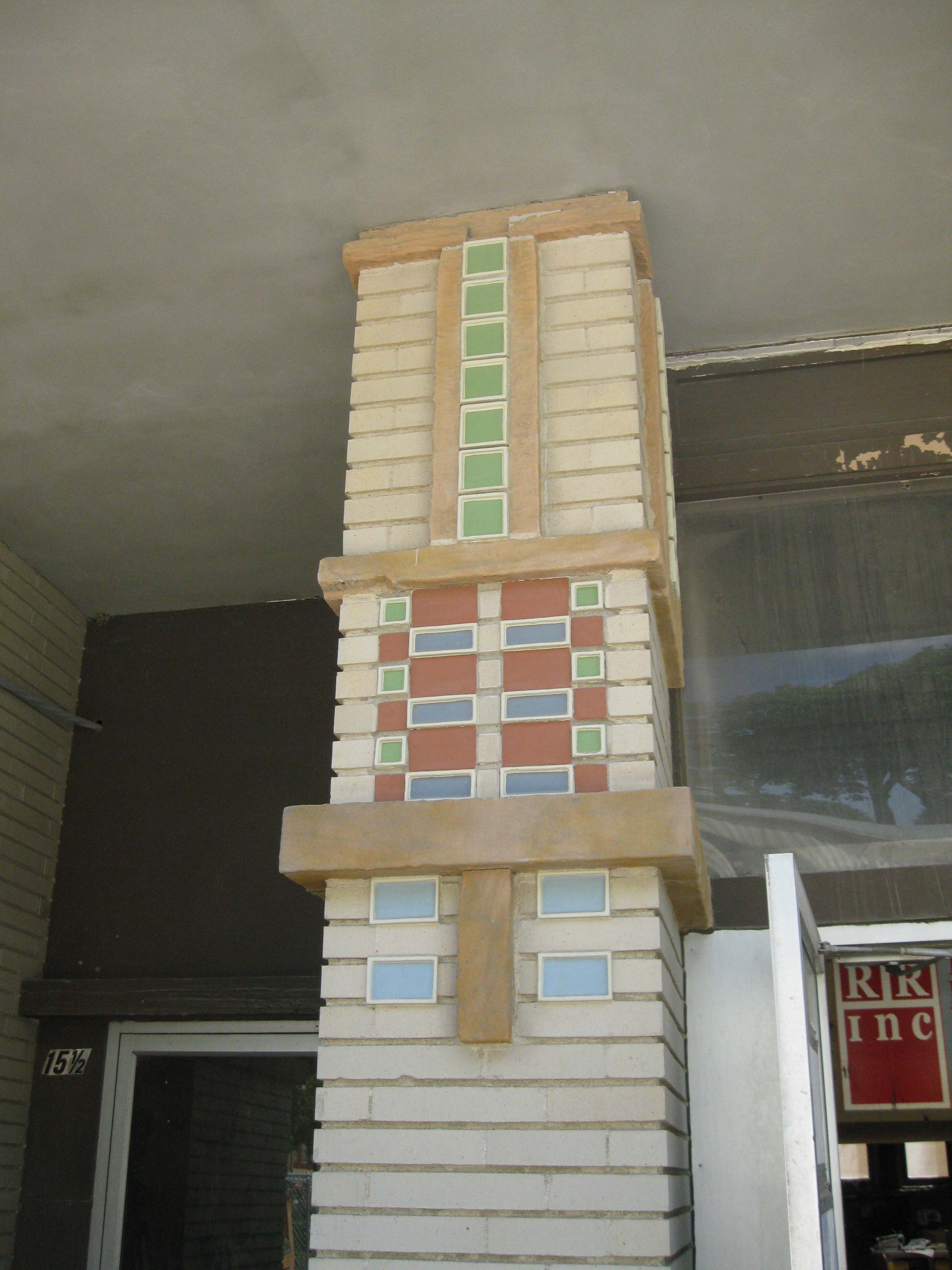Last updated: April 12, 2024
Article
Restoring the Last Frank Lloyd Wright-Designed Hotel

Photo courtesy of HABS-IA-78-1.
Prominent Mason City Attorney James E.E. Markley met Wright while visiting his daughters at Wright‘s aunt‘s Hillside Home School in Spring Green, Wisconsin. Markley and his business partner, James E. Blythe, were impressed with Wright‘s design for one of the campus buildings, and commissioned Wright to design a business block to include their law offices, a hotel, bank, and shops.
Construction started in the spring of 1909 and was completed in August 1910 under William Drummond, Wright‘s chief draftsman, after Wright abruptly left his practice to travel to Europe. When in Europe, Wright published the Park Inn project in the Wasmuth Port-folio, a collection of his drawings, that influenced many European architects. The massing of Walter Gropius‘ Model Factory, part of the Werkbund Exhibition at Cologne in 1914, is nearly identical to the massing of the Park Inn Hotel.
The Mason City business block opened in late August 1910. Wright had designed the City National Bank, on the east, and the Park Inn Hotel, on the west, as essentially separate buildings "…linked together by the lines of the heavily projecting roof slab." [1] These two main segments are symmetric within themselves and are connected by a narrow waist. The building sat across the street from Central Park, one of only a few dedicated green spaces set within an urban environment in Iowa. Wright kept the natural resource in mind and placed windows to maximize views to the park.
After the hotel‘s opening, the local newspaper ran an article praising hotel manager John Sundell for making Mason City famous. The Park Inn Hotel was described as a "model whether in the domain of eatery or sleepery." [2] The rooms were small in size and number and had shared bath facilities. The basement held a spacious guest room for the gentlemen to do reading and correspondence. The main floor included a lobby, shops, lunch room, bakery, café and kitchen. A mezzanine, where an orchestra played on special occasions, over-looked the front desk and café. On the second floor was a ladies parlor, a balcony overlooking Central Park, and hotel rooms. The third floor housed additional hotel rooms. The hotel was U-shaped, focusing inwards with rooms looking into a central glass-roofed atrium. Later that year, some second floor rooms were remodeled by Wright into the law offices of Blythe, Markley, Rule and Smith. Wright used mahogany board-and-batten trim throughout and added clerestory windows in a hallway leading to the safe.
The City National Bank‘s design was a symmetrical box. The exterior established a strong structural system of brick piers, each column capital ornamented with an organic flourish "...they were like the delicate leaves of a tree crowning the solid trunk." [3] Natural lighting through skylights and clerestory windows illuminated the first floor‘s president, cashier, and director‘s rooms and the third story‘s offices. Through a complementary massing and fenestration pattern, the bank was closed at its lower level and open above while the hotel is the opposite, "Wright brings the disparate functional elements into a highly resolved and beautifully proportioned com-position." [4] Wright‘s first venture at hotel design was a success.
Over the years, the main floors of both the hotel and bank suffered unsympathetic remodels as they were accommodated to various tenants. The most significant alteration to the bank building occurred in 1926 when a new commercial tenant moved in. The clere-story windows were removed and double-hung windows added to a new second floor, the main floor was lowered to street level, and retail display windows were cut into the once "...imposing façade of a sixteen-foot high solid masonry wall." [5]
In 1972, the Park Inn Hotel closed its doors and it, along with the City National Bank, was listed on the National Register of Historic Places. The next year, the hotel‘s upper floors were renovated into apartments; luckily the renovations did not drastically alter the building. In 1988, the City forced the tenants to relocate, after years of insufficient maintenance left the building in poor condition. By 1999, the building was listed on the '10 Most Endangered Historic Properties' by the Iowa Historic Preservation Alliance.
In 1972, the Park Inn Hotel closed its doors and it, along with the City National Bank, was listed on the National Register of Historic Places. The next year, the hotel‘s upper floors were renovated into apartments; luckily the renovations did not drastically alter the building. In 1988, the City forced the tenants to relocate, after years of insufficient maintenance left the building in poor condition. By 1999, the building was listed on the '10 Most Endangered Historic Properties' by the Iowa Historic Preservation Alliance.

Photo courtesy of Melissa Vandelac, National Park Service.
Preservation Supported through Save America's Treasures Grant from NPS
In 2000, the city of Mason City entered into a contractual agreement with The Mason City Foundation, a not-for-profit, to take on the hotel project. That same year, the city grant writer obtained aSave America‘s Treasures (SAT) grant for the hotel building. This program awards grants to federal, state, local, and tribal government entities, and non-profit organizations through a competitive matching-grant program. The grants are to be used for National Historic Landmarks (NHLs) or properties listed on the National Register with national significance, the latter the case of the Park Inn Hotel and City National Bank building. Five years later, the Mason City Foundation gave the hotel project back to the city and the city council asked citizens to step forward to take on the project.Wright on the Park, Inc., was formed three months later – with a mission to "...own, preserve, maintain and educate the public about The Park Inn Hotel and City National Bank." [6] They received ownership of the hotel and bank buildings, in 2006 and 2007 respectfully; it was the first time in over seventy years that the entire building has been under one owner. Wright on the Park received a second SAT Grant in 2008, this time for the bank building.

Photo courtesy of Melissa Vandelac, National Park Service.
Architects Bergland & Cram and Henkel Construction, along with many subcontractors, have teamed to complete this exciting renovation. Many non-period alterations have been removed to expose several original architectural features. Since 2000, the roof has been totally replaced, the building stabilized, the exterior cleaned and repointed, terra cotta tiles restored, and the mezzanine balcony in the hotel lobby, removed c.1915, put back in its original location. Many features that had been removed over time have been rediscovered.
For example, the Wright-designed large skylight, originally located behind the hotel‘s main desk, was recently found in the attic of one of the original hotel owners‘ homes. Fully restored by Clear Lake Stained Glass, the window is ready for re-installation.
Looking forward, Wright on the Park, Inc. has partnered with the Mason City Chamber of Commerce and other groups for a series of improvement projects in Mason City. These include creating park-ing for the hotel and the re-development of the plaza to the east of the building. Ann MacGregor, Director of Wright on the Park, sees the hotel, with its location, as the centerpiece for a rejuvenation of downtown Mason City.
As the only remaining Frank Lloyd Wright-designed hotel, the Park Inn Hotel is internationally, architecturally, and historically significant. It is seen as the prototype for Wright‘s Imperial Hotel in Japan and Midway Gardens in Chicago, Illinois. Also, the City National Bank Building is noted to be the better of the two remaining Wright-designed banks, the other being the First National Bank of Dwight, Illinois. The entire building exemplifies the Prairie School design – characterized by rectangular shapes, horizontal orientation, cantile-vered roof lines and open arrangements of interior spaces. Sitting at the heart of downtown Mason City, Iowa, this architectural treasure, once restored and opened next year, will bring joy to many Wright enthusiasts for years to come.
Originally published in "Exceptional Places" Vol. 5, 2010, a newsletter of the Division of Cultural Resources, Midwest Region. Written by Melissa Vandelac.
[1]. Maria Costantino, The Life and Works of Frank Lloyd Wright (London: PRC Publishing LTD, 1998), 64.
[2]. The New Park Inn is Ideal; Haven for the Transient. Mason City Globe Gazette. September 10 1910.
[3]. Alan Hess and Alan Weintraub, Frank Lloyd Wright: The Buildings (New York: Rizzoli Publications, 2008), 15.
[4]. Robert McCarter, Frank Lloyd Wright (London: Phaidon Press Ltd., 1997), 137.
[5]. Maria Costantino, The Life and Works of Frank Lloyd Wright (London: PRC Publishing LTD, 1998), 61.
[6]. Wright on the Park, Our Mission, http://www.wrightonthepark.org (June 2, 2010).
